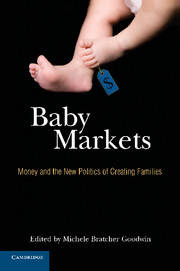Book contents
- Frontmatter
- Contents
- Preface
- Acknowledgments
- Introduction
- PART ONE WHAT MAKES A MARKET? EFFICIENCY, ACCOUNTABILITY, AND RELIABILITY OR GETTING THE BABIES WE WANT
- PART TWO SPACE AND PLACE: REPRODUCING AND REFRAMING SOCIAL NORMS OF RACE, CLASS, GENDER, AND OTHERNESS
- PART THREE SPECTRUMS AND DISCOURSES: RIGHTS, REGULATIONS, AND CHOICE
- 10 Reproducing Dreams
- 11 Why Do Parents Have Rights?: The Problem of Kinship in Liberal Thought
- 12 Free Markets, Free Choice?: A Market Approach to Reproductive Rights
- 13 Commerce and Regulation in the Assisted Reproduction Industry
- 14 Ethics within Markets or a Market for Ethics?: Can Disclosure of Sperm Donor Identity Be Effectively Mandated?
- PART FOUR THE ETHICS OF BABY AND EMBRYO MARKETS
- PART FIVE TENUOUS GROUNDS AND BABY TABOOS
- Author Bios
- Index
- References
13 - Commerce and Regulation in the Assisted Reproduction Industry
Published online by Cambridge University Press: 05 August 2012
- Frontmatter
- Contents
- Preface
- Acknowledgments
- Introduction
- PART ONE WHAT MAKES A MARKET? EFFICIENCY, ACCOUNTABILITY, AND RELIABILITY OR GETTING THE BABIES WE WANT
- PART TWO SPACE AND PLACE: REPRODUCING AND REFRAMING SOCIAL NORMS OF RACE, CLASS, GENDER, AND OTHERNESS
- PART THREE SPECTRUMS AND DISCOURSES: RIGHTS, REGULATIONS, AND CHOICE
- 10 Reproducing Dreams
- 11 Why Do Parents Have Rights?: The Problem of Kinship in Liberal Thought
- 12 Free Markets, Free Choice?: A Market Approach to Reproductive Rights
- 13 Commerce and Regulation in the Assisted Reproduction Industry
- 14 Ethics within Markets or a Market for Ethics?: Can Disclosure of Sperm Donor Identity Be Effectively Mandated?
- PART FOUR THE ETHICS OF BABY AND EMBRYO MARKETS
- PART FIVE TENUOUS GROUNDS AND BABY TABOOS
- Author Bios
- Index
- References
Summary
The assisted reproduction field has grown phenomenally since the first in vitro fertilization (IVF) birth in 1978, with more than two million births worldwide. Assisted reproductive technologies (ARTs) and their many variations are now firmly ensconced within the medical care system. In 2003, there were more than 120,000 cycles and 35,000 births annually in the United States, and perhaps 200,000 births throughout the world. These technologies are avidly sought by persons unable to have children and present an attractive career alternative for obstetrician-gynecologists.
ARTs raise both ethical and health policy issues. The ethical questions involve the status and control of extracorporeal embryos, the technologization of family and reproduction, and the ability to recombine genetic, gestational, and social parentage. The health policy issues are less sexy but just as important. These concern the high cost of the procedures and lack of access, the risk that children will be born with congenital defects, and the effects on parenting and the family.
Some people still wonder whether we have proceeded too fast in accepting technological control over conception. They fear that we have paid insufficient attention to the effect of separating and recombining the genetic, gestational, and social aspects of reproduction on children, families, and, indeed, the human narrative. Others are concerned about extensions of ARTs to nontraditional families such as single men and women or gay and lesbian couples. Still others are bothered by the prospect of extensive preimplantation genetic selection and manipulation (PGD), which external access to the embryo makes possible.
- Type
- Chapter
- Information
- Baby MarketsMoney and the New Politics of Creating Families, pp. 191 - 207Publisher: Cambridge University PressPrint publication year: 2010
References
- 1
- Cited by



